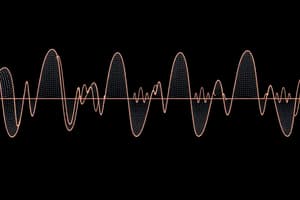Podcast
Questions and Answers
Which of the following is the most accurate description of acoustics?
Which of the following is the most accurate description of acoustics?
- The study of electrical signals in the brain.
- The study of light and its properties.
- The study of matter in a vacuum.
- The study of sound and its properties. (correct)
Sound can propagate through a vacuum.
Sound can propagate through a vacuum.
False (B)
What part of the ear is responsible for converting sound vibrations into electrical signals?
What part of the ear is responsible for converting sound vibrations into electrical signals?
cochlea
Which of the following is a strategy to reduce traffic noise in residential areas?
Which of the following is a strategy to reduce traffic noise in residential areas?
Pressure equalization in the ear occurs through the __________, which leads to the nose and throat.
Pressure equalization in the ear occurs through the __________, which leads to the nose and throat.
What is required for the sensation of sound to occur?
What is required for the sensation of sound to occur?
In physics, noise is defined as a regular oscillation, while a tone is an irregular oscillation.
In physics, noise is defined as a regular oscillation, while a tone is an irregular oscillation.
In a workplace, who is typically responsible for monitoring the work environment in terms of noise levels?
In a workplace, who is typically responsible for monitoring the work environment in terms of noise levels?
The eardrum oscillates back and forth by a millimeter when hearing the faintest sound.
The eardrum oscillates back and forth by a millimeter when hearing the faintest sound.
What is the role of the pinna in the process of hearing?
What is the role of the pinna in the process of hearing?
To prevent sound transmission in a preschool setting, the floor should not be cast in a single ______.
To prevent sound transmission in a preschool setting, the floor should not be cast in a single ______.
Match the following steps with their corresponding actions in the hearing process:
Match the following steps with their corresponding actions in the hearing process:
Match the following sources with their potential impact as disturbing sounds:
Match the following sources with their potential impact as disturbing sounds:
What should you do if you work in a noisy environment to protect your hearing?
What should you do if you work in a noisy environment to protect your hearing?
All sounds that we cannot hear are harmless to humans.
All sounds that we cannot hear are harmless to humans.
From the perspective of sustainable development, what are noise and disturbing sounds often cited as causes of?
From the perspective of sustainable development, what are noise and disturbing sounds often cited as causes of?
Which of the following best describes the difference between a tone and noise?
Which of the following best describes the difference between a tone and noise?
Overtones contribute to the unique sound of different instruments, even when they play the same fundamental frequency.
Overtones contribute to the unique sound of different instruments, even when they play the same fundamental frequency.
Define resonance in the context of musical instruments.
Define resonance in the context of musical instruments.
The frequency of a sound wave determines the ______ of the musical note.
The frequency of a sound wave determines the ______ of the musical note.
Match the following musical concepts with their descriptions:
Match the following musical concepts with their descriptions:
Why does playing the same note (e.g., A4) on a piano and a guitar sound different?
Why does playing the same note (e.g., A4) on a piano and a guitar sound different?
A tuning fork produces overtones in addition to its fundamental frequency.
A tuning fork produces overtones in addition to its fundamental frequency.
Explain how resonance contributes to the sound production of an acoustic guitar.
Explain how resonance contributes to the sound production of an acoustic guitar.
Flashcards
Acoustics
Acoustics
The study of sound and its properties.
Sound
Sound
Vibrations that travel through matter and can be heard.
Vibration
Vibration
Rapid back-and-forth motion that produces sound.
Eardrum
Eardrum
Signup and view all the flashcards
Cochlea
Cochlea
Signup and view all the flashcards
Eustachian tube
Eustachian tube
Signup and view all the flashcards
Auditory center
Auditory center
Signup and view all the flashcards
Sound in a vacuum
Sound in a vacuum
Signup and view all the flashcards
Tone
Tone
Signup and view all the flashcards
Noise
Noise
Signup and view all the flashcards
Fundamental
Fundamental
Signup and view all the flashcards
Overtone
Overtone
Signup and view all the flashcards
Frequency
Frequency
Signup and view all the flashcards
Resonance
Resonance
Signup and view all the flashcards
C Major Scale
C Major Scale
Signup and view all the flashcards
Tuning Fork
Tuning Fork
Signup and view all the flashcards
Noise Barriers
Noise Barriers
Signup and view all the flashcards
Sound-Absorbing Hoods
Sound-Absorbing Hoods
Signup and view all the flashcards
Hearing Protection
Hearing Protection
Signup and view all the flashcards
Safety Representative
Safety Representative
Signup and view all the flashcards
Disturbing Sounds
Disturbing Sounds
Signup and view all the flashcards
Infrasound
Infrasound
Signup and view all the flashcards
Good Insulation
Good Insulation
Signup and view all the flashcards
Construction Noise
Construction Noise
Signup and view all the flashcards
Study Notes
Sound and Pressure
- Acoustics is the study of sound
- Humans can hear some sounds but not all
- Sound is produced by vibrations
- Vibrations create pressure waves in the air
- Pressure waves cause the eardrum to vibrate
- The eardrum's vibrations are converted to electrical signals
- The brain interprets these signals as sound
- Sound cannot exist in a vacuum
Hearing
- The brain interprets sounds
- Vibrations from sound waves cause the eardrum to move
- These vibrations are transmitted through three tiny bones to the cochlea
- The cochlea converts these vibrations into electrical signals
- These signals are sent to the auditory center in the brain for interpretation
- For good hearing, ear pressure must match the surrounding pressure. This is regulated by the eustachian tube
Speed of Sound
- Sound travels at different speeds in different materials
- In air, sound travels at 340 m/s
- In water, sound travels faster due to closer molecules
- In metals, sound travels even faster; 5,000 m/s in aluminum and iron
Audio Sounds Different
- Sound is often illustrated as waves
- Dense air = peak; thin air = valley
- Frequency is the number of oscillations per second, measured in Hertz (Hz)
- Higher frequency = higher pitch
- Different loudness = stronger vibrations/oscillations
High and Low Tone
- High notes have higher frequencies than low notes
- The strength of the oscillation determines the loudness
- The length of the air column affects the tone of instruments like the flute
Noise
- Noise is an uneven oscillation
- Notes in music have a fundamental frequency and overtones
- Different instruments create different overtone patterns that make sounds unique
Resonance
- The guitar hollow resonates and amplifies the sounds
- The entire piano and hall vibrates during a concert due to resonance
- Resonance means vibrations are amplified by a material or space
Sounds That Are Not Heard
- Sound with frequencies below 20 Hz are called infrasound
- Sound with frequencies above 20,000 Hz are called ultrasound
- The human ear is sensitive in the range of 20-20000 Hz
- Some animals can hear sounds in other ranges
- Older people often have difficulty hearing higher frequencies than younger people
Sound That Damages
- Loud noises can damage hearing
- Prolonged exposure to loud noise is harmful, particularly to young ears
- Noise can be a source of stress and sleep problems and may worsen concentration and learning difficulties
Sustainable Development - Noise and Disturbing Sounds
- Irregular oscillations do not always sound "bad"
- Continuous noises are more problematic than sporadic noises
- Measures can be taken to reduce environmental noise
Studying That Suits You
Use AI to generate personalized quizzes and flashcards to suit your learning preferences.




